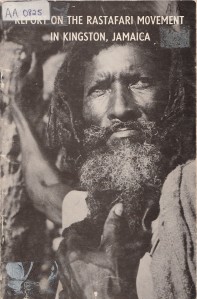Ever since I heard Robert A. Hill’s lecture in April this year titled ‘The University Report on the Rastafari Movement in Kingston, Jamaica: The half that has never been told’ I’ve wanted to blog about it. I started a post soon after but it remained a draft all this time because I felt quite inadequate to the task of conveying the brunt of what Bobby, a friend of many years standing, was saying.

That talk, sponsored by the Sir Arthur Lewis Institute of Social and Economic Studies (SALISES), where I happen to work, began with Bobby announcing:
What I’m going to talk about this evening might be rephrased as the hidden history of the University Report on the Rastafari Movement. It is hidden because in my view the report was based on considerable deception. This was not my view going into this research, I’ve spent 6 years probing, researching, trying to understand how this report came to be. It’s only in the last two months that I felt ready to go public with my findings and this evening is the first time an audience will hear the findings and I leave it to you to make your own interpretations.
After that dramatic opening Professor Hill handed out timeline worksheets, essentially Xerox copies of calendar pages with cells displaying the months April–October 1960 along with pens for those who didn’t have their own. It was important Hill said, to keep track of the dates he was going to talk about, the chronology being important, “so that we are all, not just figuratively on the same page, but literally on the same page.”
The impact, influence and staying power of the Rastafari Report, he pointed out, has far outweighed any of the other reports emanating from the University, most of which are collecting dust today. Hill remembered seeing the report for the first time as a 17-year old. “It was like a meteor had crashed into the whole world. Jamaica has never been the same since that August day when i first saw it. ”
Although first published in August 1960 when Rastafari was spelt as two words ‘Ras Tafari’ most people are familiar with the ‘edited, redacted’ version reprinted in 1968 with a Ras Daniel Heartman image on the cover. There were many reprints thereafter with different covers like the one below, reprinted in 1975. What the reprints all have in common is that they spell ‘Rastafari’ as one word, again something pointed out by Hill in the course of his lecture.
The Report was a triumph for the Rastafari movement, Hill claimed. “I’m going to say very carefully that the Report was a propaganda victory for the Rastafari Movement…but I’m not using propaganda in its sinister sense, I’m using it in its classic sense, namely the propagation of one’s beliefs.” Hill then went on to recount how the Report ‘armed the mission’ sent by the Jamaican government to Addis Ababa in 1966 to initiate conversations about the repatriation of Rastafari to Africa.
The first date Hill asked his audience to note on their worksheets was the date renowned Nobel Laureate Arthur Lewis took up his position as Principal of the University of the West Indies. April 16, 1960.
This was where I gave up, unable as i said before, to succinctly convey the gravamen of what Robert Hill was suggesting. Months later I decided to ask Bobby for an interview thinking that would be the best way to capture the sensational charges he was making against the University of the West Indies. He obliged. The interview started modestly but soon swelled to 40 pages. I agonized again over how best to present such a long document here. Finally I realized the simplest way to accomplish this was to publish it as a WordPress ‘page’.
To fully understand some of the points Bobby raises in the interview its important to remember how feared, reviled and despised Rastafarians once were. You can get a good sense of this by reading Roger Mais’s Brotherman, a novel written in the 50s or from Deborah Thomas and Junior Wedderburn’s film Bad Friday, about the Coral Gardens massacre in the 60s. Even VS Naipaul, writing of his visit to Jamaica in 1960, in The Middle Passage, talks about the fear caused by militant Niyabinghi groups pledging ‘death to the whites.’
We’ve certainly come a long way from those days especially when you consider sentiments expressed at the opening of the Rastafari exhibition at the Institute of Jamaica on July 21, 2013. “Rastafari is deeply connected to Brand Jamaica” said Lisa Hanna, Minister of Culture. And at the closing ceremony of the Kingston-leg of the Rastafari Studies Conference and General Assembly, held on the campus of the University of the West Indies (UWI), Mona, on August 15 Prime Minister Portia Simpson Miller said that Rastafari was “an important part of the image of brand Jamaica.”
Pariahs no more…the hidden history of the Rastafari and their relationship to the nation of Jamaica certainly is the perfect illustration of the biblical sentiment Bob Marley made so famous, “The stone that the builder refused, shall be the head cornerstone…
Well folks, it gives me great pleasure to present my interview with Professor Robert Hill, aptly titled Our Man in Mona. As Bobby said at the beginning of his SALISES lecture “I leave it to you to make your own interpretations.” I find Bobby’s research and findings quite persuasive but I’m also willing to be persuaded by a counter-explanation of events that is as painstakingly researched and presented as his. In the meantime I thought it important to make this provocative hypothesis widely available to keep alive that spark of agonistic engagement so lacking in the public sphere today.




